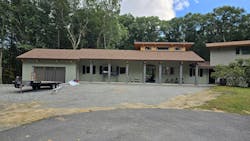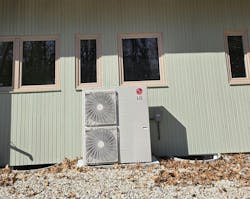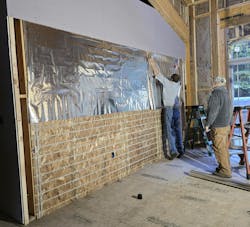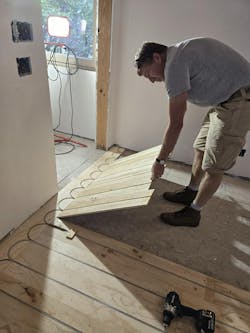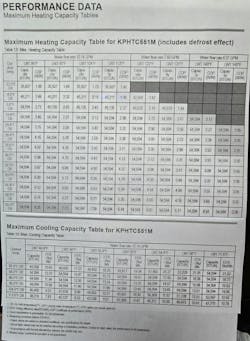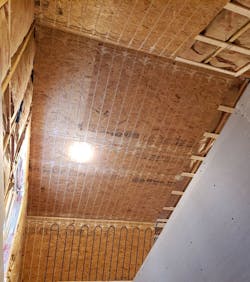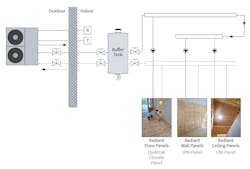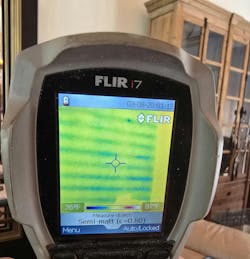Heat Pump Powers Radiant Panel Addition in Massachusetts Home
Air to water heat pumps are being introduced and recommended within the HVAC industry. Promoted by governments through sweet financial incentives, electrically-powered, super-efficient heat pump technologies are now available—not only air-to-air or ground-coupled systems, but air-to-water systems where gas-charged distribution lines from the outdoor condenser to the building's consumer stations are eliminated.
That is to say, the heat transfer from the gas to the distribution water system is taking place within the outdoor condenser unit via a flat plate heat exchanger, (monobloc units), simplifying installation.
Inverter technologies are further improving heat pump efficiencies by using variable speed compressors. This allows water temperature modulation to meet instantaneous heating and cooling demands.
This opens up endless, cost effective energy distribution possibilities, simplifying the installation down to a hydronic system, where water is the primary medium of energy transportation from the heating / cooling source to the consumers. Which is as it should be, water being the most efficient medium for the transportation of heating and cooling throughout a building.
Equipment and Specifications
In the following case study, the most common wood and aluminum panels were used, supplied by Uponor and Viega. Both companies offer complete systems—panels, tubing, manifolds and controls—under the trademark Quik Trak and Climate Panels (both companies also offer schooling and training for system design). Hydronics Manufacturing is the supplier to both of the plywood panel systems. The Specs for the project are as follows:
Location: Carlisle, Massachusetts
Type: Addition to existing home
Square Ft: 1,400 Sq. ft. living space with 1,400 sq. ft. basement and 600 sq. ft. garage space. The home has 16 ft. ceilings, up to date window glazing, R18 walls and R32 cathedral ceilings.
Main Components:
Living Space Floor 1,400 sq. ft. of Viega and Uponor aluminum-plywood panels. 450 sq. ft. of Hydronics Mfg. wall panels (Uni-Panel)
Honeywell #DR65/3000 dehumidifier
50 gal stainless steel buffer tank by Lochinvar #SBT050
Alpha 15-58F auto adapt Grundfos circulators
Zone control by Honeywell home pro series TH 6210 U 2001 thermostat plus 24V manifold powerheads.
Variable speed Heat Pump by LG model #KPHTC/551M (inverter type monobloc)
DHW: Separate dedicated by LG model # APHWC501M 58 gallon
The performance data for our heat pump clearly shows that the maximum COP (coefficient of performance) is always achieved with the lowest possible system supply water temperature for heating at any given outdoor condition, and the highest possible water temperature for cooling applications.
Our panel system with 1,400 sq. ft. of floor and 450 sq. ft. of wall panels was operating between 85 degrees F and 110 degrees F throughout the last heating season with COP values ranging from 3 to 6, depending on outdoor temperature.
1 KWH = 3,412 BTU
At an average COP of 4.5 the heat pump extracts heat from the air at the rate of 4.5 X 3,412
BTU = 15,354 BTU per KWH of electricity input.
Based on average fuel cost in the greater Boston area: $.28 kwh electricity this translates into cost savings of:
BTU/Values
$3.75 gallon #2 heating oil 140,000
$3.50 gallon propane gas 91,500
$2.50 therm (100 cubic ft.) natural gas 100,000
32% over oil
52% over propane
27% over natural gas
That is not taking into account combustion losses of fossil fuels (at least 10%). During milder outdoor temperatures (40 degrees to 60 degrees Fahrenheit), the COP value will increase to 5 and 6, meaning another 10 - 25 % savings can be expected. Energy efficiency cooling ratings of EER 13 to 15 with radiant cooling panels can be expected, based on outdoor temperature conditions.
Our system was designed with cooling in mind for two months of New England summers. A central dehumidification unit was installed to prevent condensation problems.
DHW can also be tied into the system, as can convection/radiant type radiators and fan coil units for supplemental heat.
The hydronic combinations are endless, with no gas lines inside the building and associated line length restrictions.
Air-to-water heat pumps are relative newcomers in this country. However, they have been in use for many years in Europe, primarily with single or multi-family houses, where hydronic systems are the prevalent form of heating.
The basic design criteria for maximum payback and operating efficiency is to keep water temperatures lowest with the largest possible heat emission floor areas, plus, walls and ceilings when considering radiant cooling a s well. This will guarantee a high COP and EER performance. It transforms air to water heat pumps into super efficient heating/cooling "mean machines" with fuel savings unheard of.
A perfect radiant/heat pump marriage made in heaven. See below for a simplified piping schematic of our project.
About the Author
Joe Fiedrich
Joe Fiedrich is a former hydronic heating columnist for CONTRACTOR. He was the president of Stadler Corp., which is now part of Viega North America, and he is the inventor of the Viega Climate Panel and Uponor Quik Trak. He can be reached at [email protected]. Also, visit his company Hydronicsmfg.com.

